There’s a common misconception that a ‘topical map’ is merely a list of topic clusters that a website should cover. It’s not. A list of topics is just that – a list of topics. This fundamental misunderstanding underestimates the complexity and crucial role of topical maps in search engine optimization.
What is a Topical Map? A topical map is a comprehensive blueprint that lays out your website’s main topics, subtopics, and keywords in a clear and structured way.
The map serves as a strategic guide that improves both user experience and search engine visibility. It also makes it easy for people and search engines to find what they’re looking for on your site.
This guide will break down the truth about topical maps and their role in smart SEO strategies for today’s internet. SEO has evolved over the years from keyword stuffing and link farming to a more sophisticated approach that prioritizes topical relevance and user experience for your target audience.
Let’s start with a few questions you might have before I get into it (yes, I’m starting an article with some FAQs):
- Do I need a PhD to understand this? Absolutely not. While the concept might seem complex, I’ve broken it down into more digestible parts.
- Will I be able to create a topical map after reading? No. While this article lays the groundwork by explaining what topical maps are and their significance, crafting one requires a bit more guidance. That’s why I have the Topical Maps Unlocked course.
- Are all ‘topical maps’ and services the same? No. That’s what this guide is all about.
- Can ChatGPT or other AI tools create ‘topical maps’? No. AI tools can help in the early stages with generating ideas and suggesting topics, but they lack the nuanced understanding of user intent and content relevancy to effectively structure topics into a topical map. There are currently no tools that can create quality topical maps.
Now, let’s dive in.
The Evolution of SEO: From Keywords to Topics
We have to start with a little history to understand how SEO and search algorithms have evolved from matching keywords to topics. You’ll know why “topics” are at the tip of many tongues and why topical maps are not just called “keyword maps.”
Site rankings used to be heavily influenced by keyword density, the number of times a keyword shows up, and the number of backlinks pointing to the site. Of course, there are many other factors, but that’s the simple, boiled-down version.
However, when Google’s Hummingbird algorithm was released in 2013, there was a shift of the search algorithm to understand the intent behind search queries. Topical relevance became increasingly important.
With subsequent updates, including Medic, Bert, Product Reviews, Helpful Content, and core updates, the focus continued to pivot towards:
- Search intent – What is the user searching for?
- Content’s contextual relevance – Is this relevant content for the user or not?
- Topical depth – Does the page and site provide comprehensive coverage and understanding of a specific topic? Does it provide in-depth, high-quality content?
This evolution meant that content planning required a strategic approach and investment of time and money to cover the depth and breadth of specific topics to signal expertise and relevance to search engine crawlers.
Each piece of content was no longer an isolated page of isolated keywords trying to rank. Your whole site is considered a content network of pages that reference and build upon each other in a logical structure.
That’s the start to building topical maps, the very foundation of topical authority in SEO.
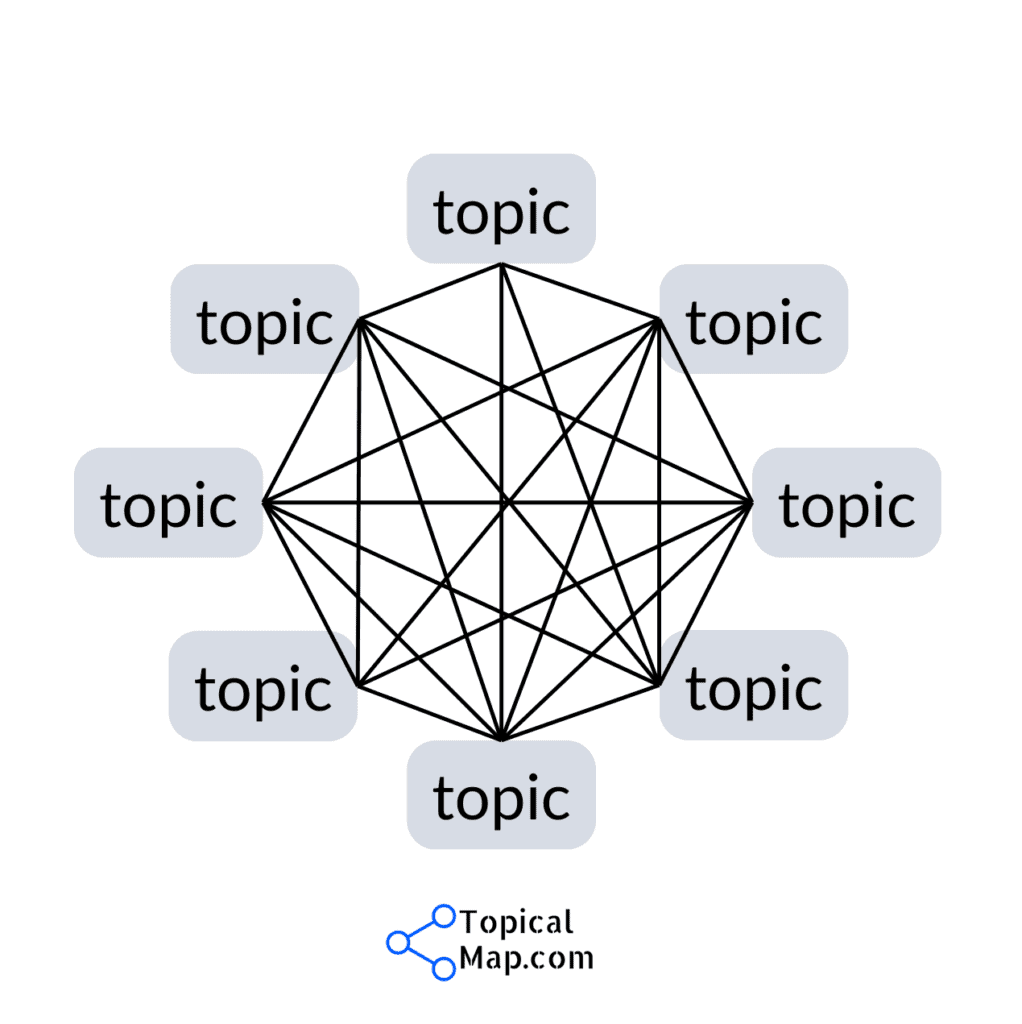
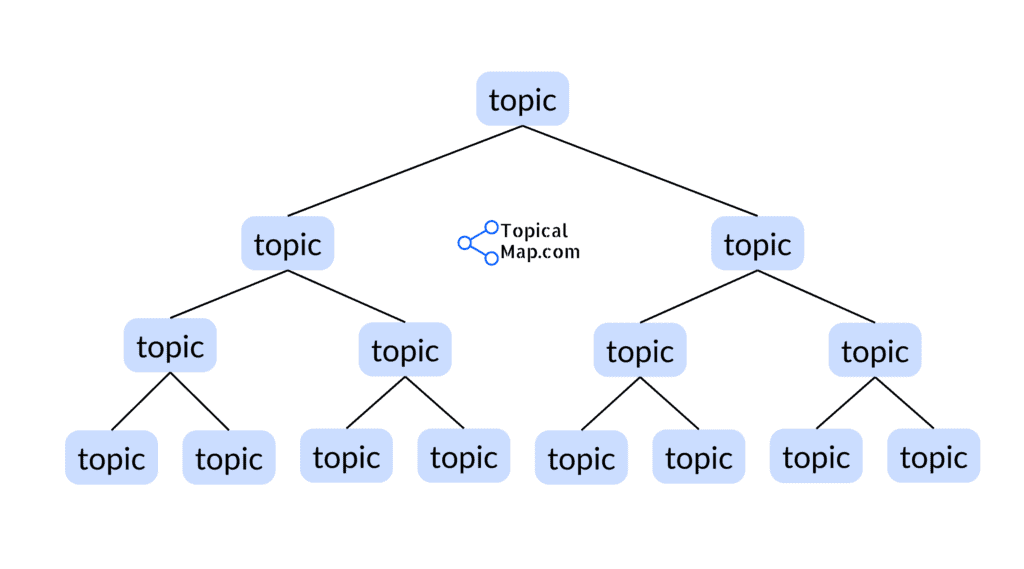
What is a Topical Map? What Does It Look Like?
A topical map is a ‘map’ of your site’s content structure and hierarchy, essential for organizing and optimizing your website for both users and search engines.
The structured hierarchy of main topics, subtopics, and related keywords mirror the logical flow of information and learning. That structure guides users, humans and search engines, on how to navigate your website and allowing search engines to comprehend and index your site more accurately.
At the center of a topical map and the site’s content is the core topic (aka seed). That is broken down into broad main topics, further into subtopics, and then individual topics.
The hierarchy is up to four levels deep, but not all may be necessary. The goal is to have a logical hierarchy that leads to easy navigation and topic comprehension.
Let’s say the core topic or theme of your site is a travel site focused on New York City. One of the main topics to any travel site is ‘Food and Drink.’ That can be broken down into restaurants, type of food, and further into specific restaurant reviews.
Here’s a small sample of what a topical hierarchy could look like:
| Main Topic | Subtopic 2 | Subtopic 3 | Individual Topics |
| NYC Food and Drink | Restaurants | American | Burgers |
| NYC Food and Drink | Restaurants | Steakhouse | Keens Steakhouse |
| NYC Food and Drink | Restaurants | Italian | Pasta |
| NYC Food and Drink | Restaurants | Italian | Pizza |
| NYC Food and Drink | Restaurants | Italian | Lasagna |
| NYC Food and Drink | Restaurants | Seafood | |
| NYC Things to Do | Attractions |
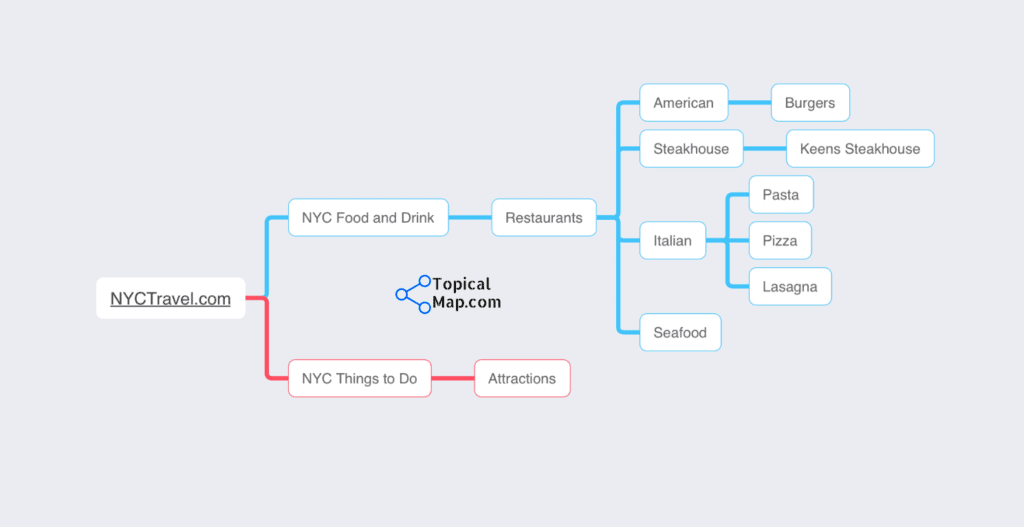
That is just one of the ways to organize the topics. What works best for a specific site will depend on its goals and target audience.
For example, if the site is focused only on restaurants and food review, you don’t need to have the ‘Food and Drink’ level too because that’s already what the whole site is about.
The topics covered should reflect the specific themes that are relevant to your target audience’s interests and needs.
A good topical map is the cornerstone of your SEO and content marketing strategies, and will help you on your way to achieving topical authority.
Achieving Topical Authority is More Than Just Content
Achieving topical authority indicates that a website is considered the go-to source for information on a set of topics by users and search engines. That leads to a positive impact on search engine rankings and organic traffic.
But there’s a misconception that topical authority is only about creating a bunch of content.
Topical authority goes beyond content creation. It’s a multi-pronged concept that embodies E-E-A-T: Experience, Expertise, Authoritativeness, and Trustworthiness.
- Experience: Hands-on understanding and life experience related to the topics.
- Expertise: Demonstrated by in-depth knowledge or skill.
- Authoritativeness: Other reputable sites within the same industry recognize your site as a reference.
- Trustworthiness: Earned through accurate and honest content that users find reliable and safe.
As you can see, building an authoritative site can’t be achieved simply by just creating content. Content quality, authors, mentions from other reputable sites, social media presence, policy pages, and backlinks all contribute to topical authority.
Topical maps even affect your link building. If you have no clear topical direction of your site, you might be building links from unrelated and unhelpful sites. Search engines like Google want to see backlinks from topically-related sites. If you had a casino site link to your NYC travel site, there isn’t any relevance there and could be seen as link manipulation.
A topical map is just one aspect of topical authority, but it’s also a powerful one. It presents a clear hierarchy and organization structure that tells users and search engines your site is an authority on all the topics.
Topical Hierarchy and Its Strategic Importance
Topical hierarchy is what separates the wannabe ‘topical maps’ from the real topical maps.
Hierarchy is the backbone of good site architecture, allowing for an intuitive structure that users and search engines can easily navigate. It creates that logical flow of information from a central topic to broad topics down to specific subtopics and relevant keywords.
If all you have is a list of keyword clusters or topic clusters, how do you set the navigation for users? If you are trying to sell a product or service, you understand how important the customer journey is.
Let’s take an example from ecommerce with an online shoe store. The shop sells all kinds of athletic shoes, including basketball and running shoes. Each sport shoe also has brands like Nike and Adidas, as well as multiple color options like blue and black.
Imagine the number of iterations and SKUs an online shop could have(!). Without an organized content strategy, they’d have random content gaps all over their site.
Let’s try to organize some products and product categories for the shoe site depending on what a service actually provides you when they say you get delivered a ‘topical map’ –
| List of Keyword Clusters – 1 Level | List of Topic Clusters – 2 Levels |
|
|
| Topical Map (Us) – Up to 4 Levels of Hierarchy |
|
| List of Keyword Clusters | List of Topic Clusters | Topical Map |
|
|
|
Here’s an image with all three site architecture layouts next to each other:
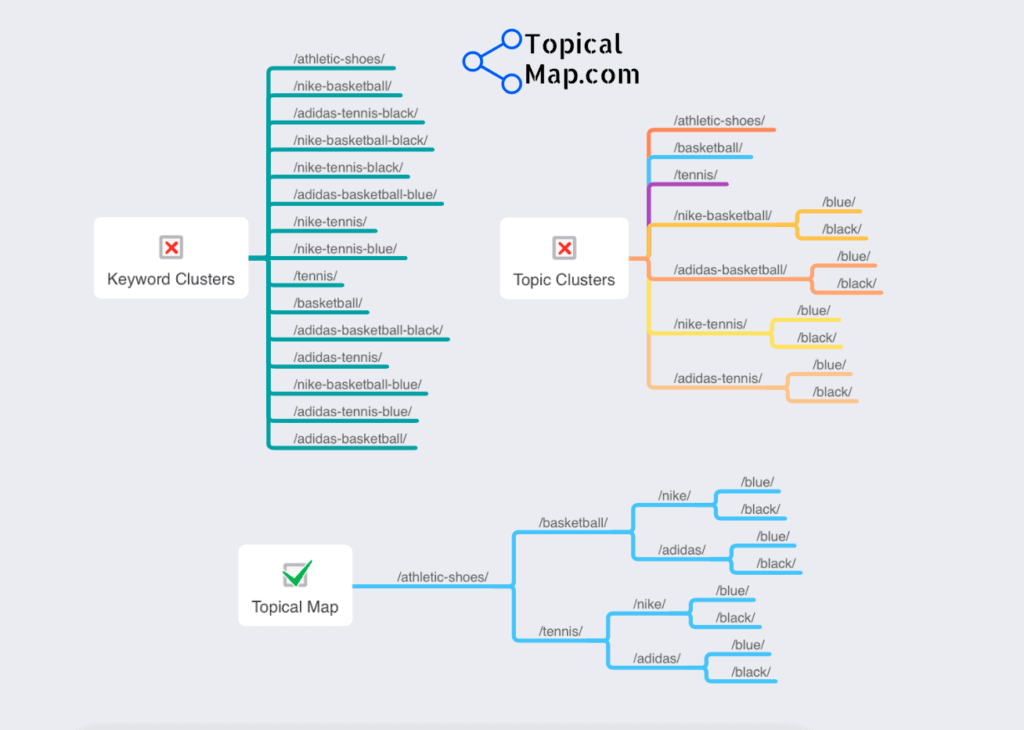
The hierarchy isn’t an arbitrary arrangement. It’s a calculated structural design where each level of the hierarchy adds detail and context to the one before it. With clear distinctions between topics and levels, you can avoid keyword cannibalization.
This clean hierarchical organization can significantly improve a site’s SEO, showcasing relevance and expertise to search engines. It can also improve user engagement metrics.
If you were a search engine bot, which of those would be easiest for you to crawl and understand the relationships between topics? The more the bot struggles understanding your site, the less that it will want to visit and index your site.
If you were a visitor who wanted to buy a pair of black Nike basketball shoes, what site structure will give you an easier time to navigate? The more the user struggles to find products, the lower number of sales you will have.
Don’t let your content efforts go to waste and lose out on its ranking potential by not creating and implementing a topical hierarchy.
Google’s SEO Starter Guide Says Topical Hierarchy is Important
Google updated their SEO Starter Guide in February 2024 (link). They condensed the guide from 8,000 words to 4,000 words to focus on the most important aspects of SEO. Organizing the website’s topics is at the top of the list of what’s most important.
This is what Google says organizing a site when you’re setting it up or redoing it:
“It can be good to organize it in a logical way because it can help search engines and users understand how your pages relate to the rest of your site.”
Google SEO Starter Guide
They also give suggestions on using directories (or folders) to group similar topics together – like what we did above with the various athletic shoes.
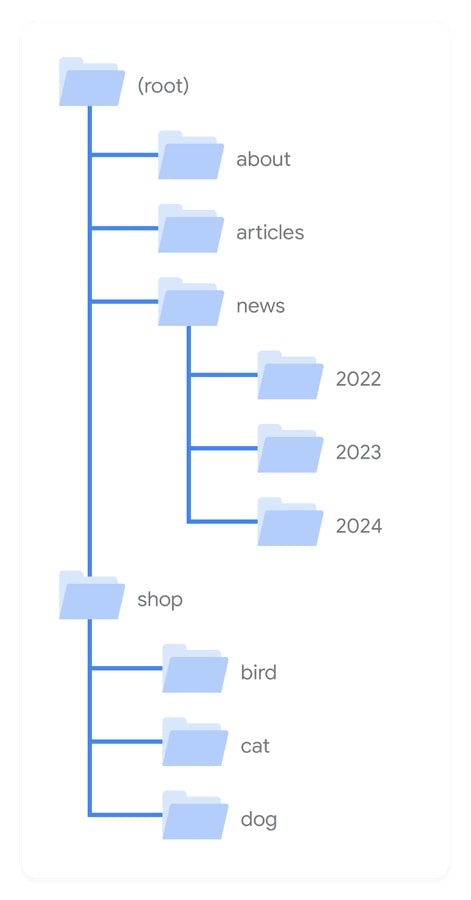
Good site organization and topical hierarchy will help Google crawl your site for indexing and ranking. Their Googlebot follows the internal links to understand your site, so the easier you make it for them, the better it is for you.
In the SEO starter guide, Google says “the vast majority of the new pages Google finds every day are through links, making links a crucial resource you need to consider to help your pages be discovered by Google and potentially shown in search results.” They share this image that looks similar to some of the images above:
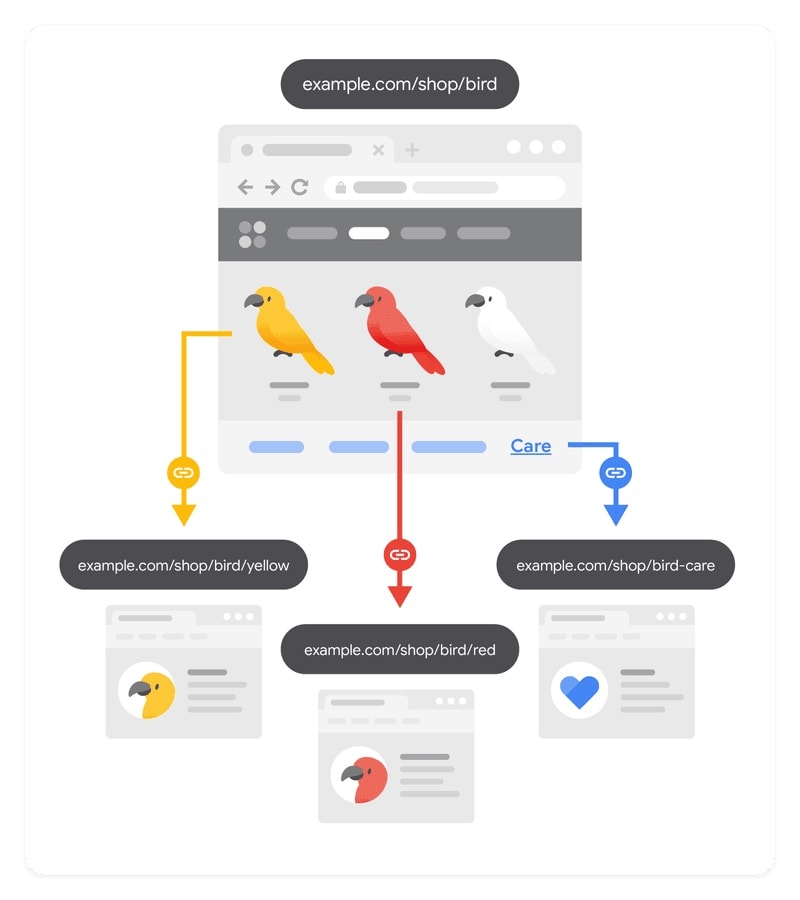
Your topical map and topical hierarchy will guide you through how to internally link to relevant sources. No jumping through hoops with other tools or using Google to search for a relevant page on your site.
Topical Maps vs. Topic Clusters
Topical maps are not just a simple list of topic cluster; that should be called a ‘topical list.’
Topical maps are so much more. They provide an interconnected structure of the topics that mirrors the site’s architecture. Think of the topic structure like the structure of college courses.
In the US, colleges label their course titles with 101, 201, 301, 401, etc. The first numbers represent the difficulty level of the courses and the natural progression of learning about a central topic.
Let’s use Psychology to show how the courses evolve in complexity and depth as they progress from the 101 level to 401 level.
- Psychology 101: Introduction to Psychology
- The broad base layer of the course (topical map) that serves as the foundation of the basic concepts and theories of psychology.
- Psychology 201: Developmental Psychology
- Building on the foundational basics, this course examines the psychological growth and changes that occur from infancy to adulthood.
- Psychology 301: Abnormal Psychology
- Now that you have a good understanding of the basics and the natural growth progression, this course covers the range of disorders that could occur, including mood disorders, anxiety disorders, psychotic disorders, and personality disorders.
- Psychology 401: Cognitive Neuroscience
- At this advanced level, only a few people will get here. It’s the smaller corners of the central topic of Psychology, the long-tails of topics.
If all you received is a list of topics with the four courses, the flat list provides no clarity on the relationships and relevance between topics. But a topical map will connect the dots and show how each course and each topic serves a specific purpose for the central topic.
Connecting the dots and internal linking strategies are where a topical map really shines. Unfortunately, it’s also where many people struggle when creating topical maps.
Site Architecture and Navigation: Essential for Bots and Users
Good site architecture offers clear navigation paths to search engine bots and users for streamlined user experiences (UX). Bad site architecture leads to bot and user confusion.
Topical maps are the start of any site architecture plan because it’s all about how to lay out the semantic relationships between topics. And internal links are how crawlers will understand your site architecture.
Internal links help with site navigation, establish information hierarchy and spread link juice throughout your site.
Internal links create the paths from one piece of content to another. It demonstrates to search engines the site’s organization for its central theme or topic.
For example, if a “Psychology 201” page links to a “Psychology 101” and/or “Psychology 301” page, you’re illustrating that the site has more topics on Psychology and users can navigate to them easily. It reinforces the site’s comprehensive content coverage and topical authority. That’s great for SEO and user engagement.
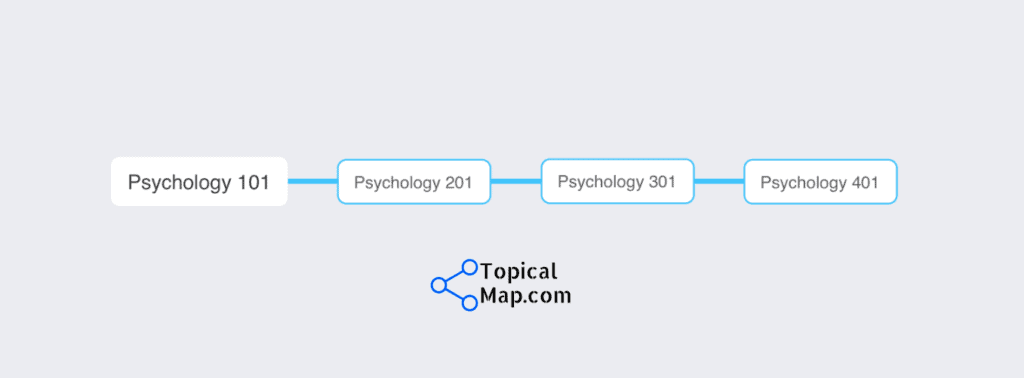
But if your “Psychology 201” page links to a “Computer Science 101” page, you’ve lost credibility because there’s no clear content relevance here. The only connection is that both pages are on the same site. It doesn’t help and shows that there isn’t a clear focus or strategy with site architecture and internal linking.
Go back up to the topical lists of athletic shoes and see what will give you the least amount of headaches when internally linking articles. If you and your writers have to spend time thinking about what’s relevant to link to, just imagine what your users and search engine bots are thinking.
Implementing Topical Maps in Your SEO Strategy
Topical mapping and implementation aren’t difficult, but it is an involved process and requires careful planning and execution.
Here’s the general overview of the topical map and content creation process:
- Topical Research – Deep research to identify the main topics, subtopics, and keywords that are relevant to your audience.
- Cluster – Cluster the keywords according to the SERPs (This is where most ‘topical map services’ stop).
- Hierarchy – Organize the keyword clusters into a hierarchical structure to create a topical map with internal linking strategy.
- Content Creation – The topical map guides you what content to create and how each piece fits into the bigger picture.
Once you have your writers reading the topical map, they’ll be able to easily see what articles to write and what articles they should be internally linking to.
Writers can write articles on main topics and relevant subtopics together, allowing them to write more efficiently and with more depth.
If the writer is writing articles on Psychology 101, 201, 301, and 401 together, they’ll be able to better plan and execute. It’s a big time saver and you get ever greater content out of it.
A topical map and systematic approach to content creation in your SEO strategy is one of the major keys to achieving success and long-term growth. Investing your time and resources into a strong topical map will give you a big head start against your competitors.
Want a Topical Map?
Ready to unlock your website’s full potential? Secure your tailor-made Topical Map today by heading over to the topical map order page.
Simply fill out your site information and seed keyword details on the order page to start your journey to SEO success.
Here’s some key information to know that makes us stand out:
- No matter the package ordered, we always provide the topical hierarchy and internal linking strategy.
- We don’t impose an arbitrary limit on the number of topics delivered because topical maps are about complete topical coverage.
No matter who you end up working with on your topical map, make sure you ask about hierarchy, internal linking, and if there are any topic limits.
Send us an email if you have any questions about our topical maps.


Footy.com have implemented their URL architecture in exactly the way you’ve described here (for people that want to see it in the wild)
Thanks for sharing!
Thank you brother nice article
Thanks!